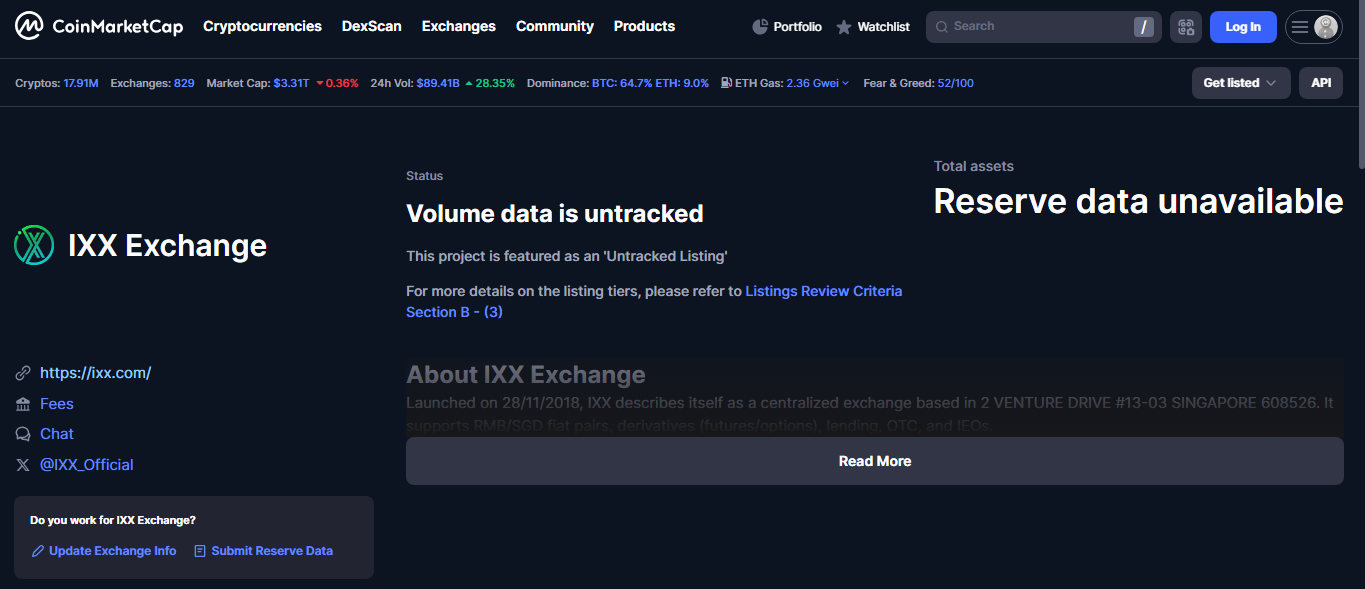IXX Exchange Review – from broad ambitions to silent closure

IXX Exchange launched in Singapore at the end of 2018. It tried to position itself as a full-featured, global crypto exchange. From the start, it aimed to handle everything: spot trading, futures, options, token launches, fiat currency pairs, and even lending. They also introduced an over-the-counter service and built a standalone desktop app. The platform set out under bold slogans about creating a “nation for blockchain trading,” hoping to draw both retail and institutional users.
Early materials claimed the company had backing from several investment funds, plus a leadership team that included graduates of schools like MIT and Yale. On paper, it looked ambitious and well-connected.
Trading activity and real-world traction
Despite big promises, IXX never published convincing data on trading volume or liquidity. Independent sites often either couldn’t track it at all or marked it as inactive. Over time, the exchange fell off most industry radars. The number of listed assets was supposed to exceed fifty cryptocurrencies, with multiple fiat pairs like RMB and SGD. Yet without any visible trading data, it was hard to see if actual users traded there in meaningful numbers.
Eventually, IXX’s volume was so low that many trackers flagged it as having no activity. From a trader’s point of view, that meant even if you wanted to use the platform, placing large orders would be risky due to potential slippage and thin books.
Fees and payment options
IXX promoted itself with competitive fees - roughly 0.05% for makers and 0.1% for takers. They allowed deposits via credit cards, debit cards, and bank transfers, trying to appeal to newcomers who preferred fiat onramps. But since volume remained unclear, it was tough to judge whether these low fees translated into real-world savings. A low fee doesn’t help much if there’s no liquidity or if spreads widen because hardly anyone is trading.
Security, transparency, and oversight
On the security front, IXX claimed to have rigorous systems in place. It spoke about advanced protection for funds, custody practices, and strong tech teams. However, these were self-published claims with no visible third-party audits or independent certifications to back them up.
Regulatory transparency was another major gap. The platform did not operate under licenses from recognized global financial authorities. Without regulatory filings or an official compliance framework, traders had to take the company’s word that it followed best practices. For many, that level of trust was too much to ask.
User experiences and reputation over time
Community impressions of IXX were mixed. A few early users praised the wide set of products and the slick interface, suggesting it had potential. But as time went on, complaints became more common. Some users reported delays in withdrawals, unclear customer support processes, or unusually aggressive marketing urging them to deposit more. Others pointed out how difficult it was to confirm ownership details or find any meaningful public documentation on how the exchange was structured.
Eventually, as trading dried up and fewer people reported using the platform, concerns about transparency grew. Without real user stories of consistent positive experiences - and without independent verifications of reserves or operations - IXX started to look more like a risky venture than a stable trading venue.
Strengths and weaknesses in hindsight
Strengths
- Offered a broad lineup: spot, futures, fiat gateways, lending, OTC services
- Promoted itself as backed by serious investors and global talent
- Supported credit and bank card deposits, plus several fiat currencies
Weaknesses
- No licensing from reputable regulators or clear compliance disclosures
- Trading activity fell to zero, making the platform functionally inactive
- Widespread trust issues tied to missing data and ownership opacity
- User complaints about delays and questionable marketing tactics
Who might have used it - and why it faded
At launch, IXX probably appealed to traders looking for a single place to handle spot trades, leveraged contracts, fiat onramps, and even token sales. In particular, people in Southeast Asia might have found it useful because of support for regional currencies.
However, without liquidity, transparent financial records, or robust oversight, the platform struggled to keep interest. Users who valued security and clarity over broad promises eventually looked elsewhere. As more regulated exchanges became available, IXX’s model couldn’t compete, especially given the doubts about operations and safety.
Final thoughts
IXX Exchange had the outline of a strong crypto hub: multiple services, low fees, and international marketing. But it never backed those features with clear trading data, third-party security checks, or firm regulation. Over time, trust eroded. The exchange stopped being active, leaving behind a story that’s familiar in crypto - a project that launched with energy and ideas but failed to build the transparency and reliability needed to last.
Today, it stands mostly as a cautionary example. For traders, it’s a reminder to prioritize platforms with clear records, known leadership, external audits, and regulatory frameworks that protect customer funds. Those elements often matter more than flashy product menus or low advertised fees.
Disclaimer
“This content is for informational purposes only and does not constitute financial advice. Please do your own research before investing.”
.png)







%203.svg)
%203.svg)




















